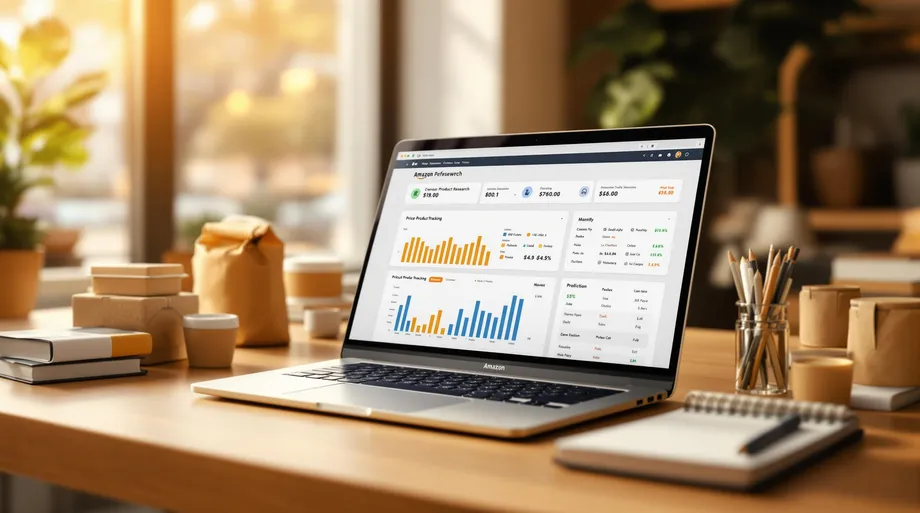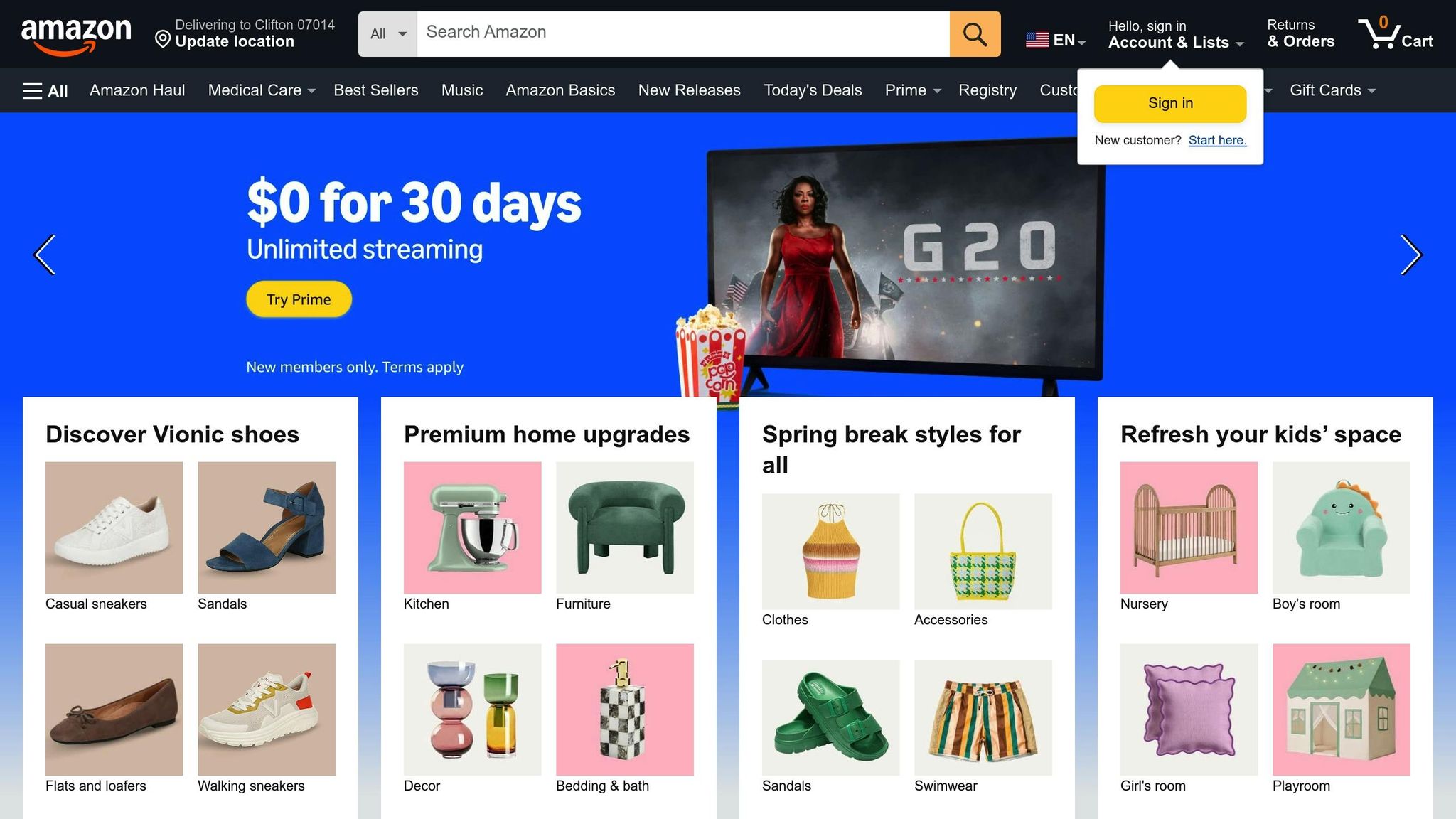
- Harsh Maur
- April 3, 2025
- 7 Mins read
- WebScraping
How does amazon scraping helps in product research?
Amazon scraping is a method businesses use to collect data from Amazon’s platform, helping them make smarter product decisions. This process automates the gathering of key information like prices, reviews, trends, and inventory levels, offering critical insights for e-commerce success. Here's why it matters:
- Track Competitor Prices: Stay competitive with real-time price data.
- Analyze Customer Reviews: Understand what buyers love or dislike.
- Forecast Demand: Use sales rank and stock trends to predict market needs.
- Spot Market Trends: Identify emerging opportunities quickly.
- Improve Inventory Management: Avoid overstocking or running out of stock.
With over 350 million products on Amazon and millions of daily price changes, scraping tools simplify data collection, enabling businesses to act faster and smarter. However, ethical practices and compliance with Amazon’s guidelines are crucial for long-term success.
Understanding Amazon Scraping

Amazon scraping automates the process of gathering data from Amazon's marketplace. It provides structured information that businesses can use for better market analysis and decision-making. Below, we'll break down the key data points you can extract and how the process works.
Types of Data You Can Extract
Amazon scraping allows you to collect a variety of data points that are essential for product research and competitive analysis. Here's a closer look:
| Data Category | Specific Elements | Business Use |
|---|---|---|
| Product Details | Title, Description, Features, Images | Understand how products are marketed and presented |
| Pricing Data | Current Price, Price History, Deals | Monitor competitor pricing and promotions |
| Performance Metrics | Sales Rank, Stock Status | Assess demand and inventory trends |
| Customer Feedback | Ratings, Reviews, Q&A | Gain insights into customer preferences and opinions |
| Seller Information | Merchant Names, Fulfillment Methods | Keep an eye on the competition and distribution models |
The Data Collection Process
Once you've identified the data points you need, the scraping tool works through a structured process to gather them efficiently.
-
Initial Setup
The process starts by configuring specialized software tailored to Amazon's website structure. The tool is set to target specific data fields, ensuring accurate and detailed product research. -
Data Extraction
The tool navigates product pages and collects relevant details, such as:- Product titles and descriptions
- Prices from multiple sellers
- Delivery options and stock availability
- High-resolution product images
- Customer ratings and review counts
-
Data Processing
After extraction, the data is organized into structured formats like CSV or JSON. The tool also validates the data, flags incomplete entries, and timestamps updates for better tracking.
Important: Amazon's guidelines require the use of proper request delays and proxies to avoid detection. For large-scale operations, storing the extracted data in cloud-based systems ensures easy access and scalability. This method provides businesses with up-to-date market insights, helping them make informed product decisions.
Main Uses in Product Research
Amazon scraping has changed the game for businesses conducting product research, offering data-driven insights that help with smarter decision-making. This includes keeping an eye on competitors, spotting market trends, and fine-tuning pricing strategies.
Tracking Competitor Products
Amazon scraping makes it easier to monitor competitors by automating the process. It delivers detailed data on what competitors are doing and how they’re positioned in the market.
| Monitoring Aspect | Data Points | Insights Gained |
|---|---|---|
| Products | ASINs, Categories, Variations | Helps refine product lines |
| Performance | Ratings, Reviews, Prime Status | Benchmark competitor success |
| Market Presence | Stock Levels, Shipping Options | Guides the distribution strategy |
For example, a study of Nike footwear sellers on Amazon uncovered some telling data: the leading seller, Shoe Webster, had 232 pairs in stock, far ahead of others. Additionally, Prime-eligible products (3,631 pairs) outnumbered non-Prime items (2,467 pairs), underscoring how crucial Prime status is for market visibility. Insights like these help businesses detect larger market trends.
Spotting Market Changes
Amazon scraping isn’t just about tracking competitors - it’s also a tool for keeping tabs on the bigger picture. By analyzing customer behavior and inventory data, businesses can identify new trends as they emerge.
Key areas to focus on for spotting market changes include:
- Customer Sentiment: Using Natural Language Processing on reviews to understand consumer opinions
- Demand Shifts: Watching stock levels and changes in sales ranks
- Category Trends: Tracking new product features and specifications
- Seasonal Patterns: Reviewing historical data to predict cyclical demand
Setting Better Prices
Dynamic pricing on Amazon is a major advantage, and scraping tools make it easier to stay competitive. Amazon itself makes over 2.5 million price changes every day, showing just how fast the pricing environment can shift.
The benefits of data-driven pricing include:
- Higher Profit Margins: Amazon’s approach to price optimization has boosted annual profits by 25%
- Quick Adjustments: Real-time pricing lets businesses react instantly to market changes
- Competitor Insights: Automated tools can track competitor pricing trends
To stay ahead with pricing strategies:
- Set up regular scraper updates to collect fresh price data
- Keep an eye on competitor price movements
- Analyze how customers respond to price adjustments
- Fine-tune prices to maximize profits
sbb-itb-65bdb53
Steps to Start Amazon Scraping
Amazon scraping requires careful planning and the right tools to get the job done efficiently.
Choosing the Right Tools
Different tools are suited for different needs. Here's a quick comparison:
| Tool Type | Best For | Features | Cost Range |
|---|---|---|---|
| Browser Extensions | Beginners, small tasks | Simple setup, basic functions | $0–$30/month |
| Desktop Applications | Medium-scale projects | Advanced options, scheduling | $50–$200/month |
| Cloud Platforms | Large-scale operations | Automation, API access | Custom pricing |
For instance, in January 2023, a market research firm used an Amazon scraping API to gather data on over 1 million products across 10 categories. This approach cut their data collection time by 40% and boosted accuracy by 25% compared to manual efforts.
Once you've selected your tools, it's time to define your data goals.
Defining Your Data Goals
Pinpoint the exact data you need to collect. Here are some common types:
- Product Details: Names, prices, ASINs, and other key identifiers.
- Market Metrics: Sales rank, stock availability, and Prime eligibility.
- Customer Data: Ratings, review counts, and sentiment analysis.
- Competitive Information: Seller details and shipping options.
Making the Most of Your Data
To turn raw data into usable insights, it’s essential to organize and analyze it effectively.
- Data Storage: Use a structured database to store your data. CSV and JSON formats are popular for their compatibility with analytical tools.
- Regular Updates: Automate scripts to refresh your data regularly, ensuring it stays relevant.
- Analysis Methods: Apply structured analysis to extract insights. Here's how different methods can help:
| Analysis Type | Goal | Results |
|---|---|---|
| Price Tracking | Monitor pricing trends | Price trend reports |
| Inventory Analysis | Spot stock patterns | Demand forecasts |
| Review Analysis | Gauge customer sentiment | Product improvement insights |
| Competitor Monitoring | Understand competition | Market position reports |
Common Problems and Rules
Amazon's Security Measures
Amazon uses various tools to safeguard its platform against automated data collection. These include IP blocking, CAPTCHA challenges, and JavaScript obfuscation. Each of these requires specific strategies to address effectively.
| Security Measure | Impact | Suggested Mitigation |
|---|---|---|
| IP Blocking | Denies access | Use rotating proxy networks |
| CAPTCHA Challenges | Interrupts data collection | Employ CAPTCHA-solving techniques |
| Rate Limiting | Limits the number of requests | Add 2–5 second delays between requests |
| Bot Detection | Flag suspicious activity | Randomize User-Agent strings and rotate browser fingerprints |
These challenges highlight the importance of technical preparation and respecting Amazon's guidelines.
Following Amazon's Rules
Beyond overcoming technical barriers, staying within Amazon's policies is essential for long-term data collection. To comply with their terms of service and reduce legal risks, follow these guidelines:
"To discuss automated access to Amazon data please contact api-services-support@amazon.com." - Amazon
Key practices include:
- Mimicking natural user behavior by introducing delays
- Using authentic browser User-Agent strings
- Avoiding excessive simultaneous requests
- Respecting the instructions in Amazon's robots.txt file
- Ensuring customer privacy is safeguarded
Checking Data Accuracy
Accurate data is critical for effective product research on Amazon. However, dynamic pricing and frequent updates can impact data reliability. To ensure accuracy, implement these practices:
Data Verification Process:
- Cross-check trends using historical data
- Use automated tools to confirm price ranges
- Identify and review anomalies or outliers
- Monitor inventory levels for consistency
For instance, a sudden, sharp price drop is often a sign of a data error rather than a true market shift. Similarly, an unexpected inventory jump, like going from zero to a large stock, should trigger a review.
Best Practices for Data Quality:
- Set up automated alerts for unusual data patterns
- Collect data from multiple sources for validation
- Regularly clean and update your dataset
Amazon Scraping: A Key to Smarter Product Research
Amazon scraping plays a crucial role in data-driven product research, helping businesses make smarter decisions in the competitive e-commerce world. By extracting and analyzing product data, companies can gain an edge over competitors.
This process isn't just about tracking prices. It opens the door to deeper market insights - like monitoring competitors, assessing inventory trends, and analyzing customer feedback. These insights can highlight opportunities and reduce risks in product strategies.
That said, success with Amazon scraping requires careful execution. While the technology offers powerful tools for gathering data, it’s important to follow ethical practices that align with Amazon’s guidelines and technical constraints.
To get the most out of Amazon scraping:
- Verify your data to ensure it’s accurate and reliable.
- Follow ethical practices to stay compliant with Amazon's rules.
- Focus your data collection on specific business goals.
- Store data efficiently in formats like JSON or CSV for easier analysis.